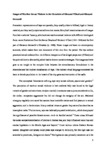Images of wartime sexual violence in the chronicles of Giovanni Villani and Giovanni Sercambi☆
| dc.contributor.author | Bokody, P | |
| dc.date.accessioned | 2021-09-23T08:51:42Z | |
| dc.date.available | 2021-09-23T08:51:42Z | |
| dc.date.issued | 2021-09-01 | |
| dc.identifier.issn | 0269-1213 | |
| dc.identifier.issn | 1477-4658 | |
| dc.identifier.other | rest.12768 | |
| dc.identifier.uri | http://hdl.handle.net/10026.1/17922 | |
| dc.description.abstract |
<jats:title>Abstract</jats:title><jats:p>Visual evidence on the perception of sexual violence from the communal period of Italy is limited. Diana Wolfthal in her groundbreaking study of medieval and early modern rape imagery showed that representations in these periods could have a critical component, and depicted these atrocities without sanitizing or eroticizing the act. This study develops on Wolfthal’s thesis by examining two sets of contemporary images from fourteenth‐century Tuscany: the Nuova Cronica of Giovanni Villani (1341–48) and the first part of Giovanni Sercambi’s Croniche (<jats:italic>c</jats:italic>.1400). In these works, the sack of a city appears to be the primary context of large‐scale and excessive sexual violence. In addition to their unanimous condemnatory angle, these texts and images also reveal different ideological motivations. Whereas Villani aimed at discarding the eventual charge of sexual violence against his hometown, Sercambi described the impact of mass rape on some cities. The chronicles use laconic and circumlocutory terms to report about the atrocities, which is matched with the sporadic presence of women in the imagery. In this limited visual language, the construction and destruction of city‐walls and gate may express the harm inflicted on the female bodies and, by extension, on the entire urban community.</jats:p> | |
| dc.format.extent | 565-589 | |
| dc.language | en | |
| dc.language.iso | en | |
| dc.publisher | Wiley | |
| dc.rights | Attribution-NonCommercial-NoDerivatives 4.0 International | |
| dc.rights | Attribution-NonCommercial-NoDerivatives 4.0 International | |
| dc.rights | Attribution-NonCommercial-NoDerivatives 4.0 International | |
| dc.rights.uri | http://creativecommons.org/licenses/by-nc-nd/4.0/ | |
| dc.rights.uri | http://creativecommons.org/licenses/by-nc-nd/4.0/ | |
| dc.rights.uri | http://creativecommons.org/licenses/by-nc-nd/4.0/ | |
| dc.subject | Giovanni Sercambi | |
| dc.subject | Giovanni Villani | |
| dc.subject | wartime sexual violence | |
| dc.title | Images of wartime sexual violence in the chronicles of Giovanni Villani and Giovanni Sercambi☆ | |
| dc.type | journal-article | |
| dc.type | Article | |
| dc.type | Early Access | |
| plymouth.issue | 4 | |
| plymouth.volume | 36 | |
| plymouth.publication-status | Published | |
| plymouth.journal | Renaissance Studies | |
| dc.identifier.doi | 10.1111/rest.12768 | |
| plymouth.organisational-group | /Plymouth | |
| plymouth.organisational-group | /Plymouth/Faculty of Arts, Humanities and Business | |
| plymouth.organisational-group | /Plymouth/REF 2021 Researchers by UoA | |
| plymouth.organisational-group | /Plymouth/REF 2021 Researchers by UoA/UoA32 Art and Design: History, Practice and Theory | |
| plymouth.organisational-group | /Plymouth/Users by role | |
| plymouth.organisational-group | /Plymouth/Users by role/Academics | |
| dcterms.dateAccepted | 2021-06-29 | |
| dc.rights.embargodate | 2023-9-1 | |
| dc.identifier.eissn | 1477-4658 | |
| dc.rights.embargoperiod | Not known | |
| rioxxterms.versionofrecord | 10.1111/rest.12768 | |
| rioxxterms.licenseref.uri | http://creativecommons.org/licenses/by-nc-nd/4.0/ | |
| rioxxterms.licenseref.startdate | 2021-09-01 | |
| rioxxterms.type | Journal Article/Review |



